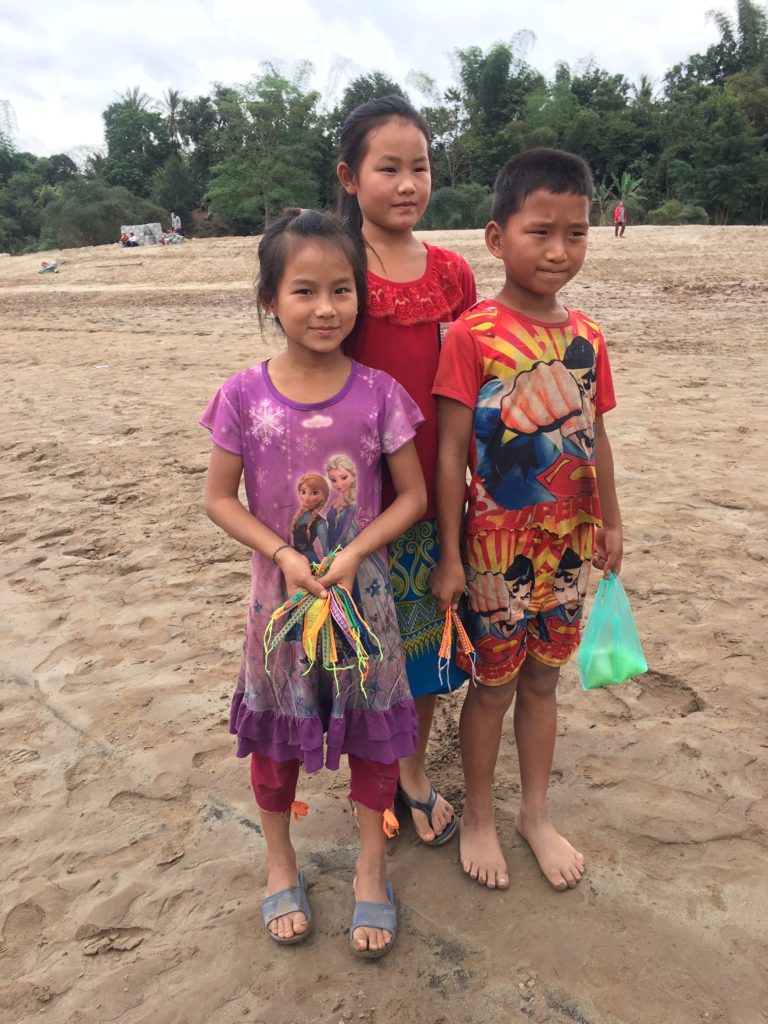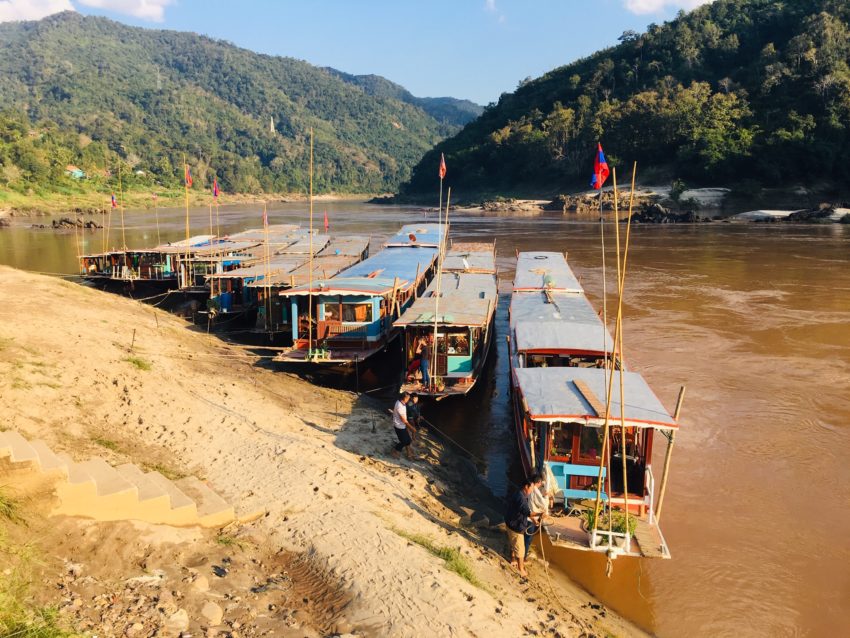There are many ways to travel from Chiang Rai to Luang Prabang (in Laos). As the crow flies its only 200 km. However, that crow would have to fly over several mountain ranges blanketed in dense jungle. As a result, there is no direct route. You can spend a full day flying there by backtracking to cities like Bangkok and Jakarta. You can drive three hours back to Chiang Mai and take the one daily direct flight. You can board a 15 hour overnight bus that circumnavigates these mountains on serpentine roads. Or you can choose to ride down the mighty Mekong river on a boat. The river snakes through these mountains and by water its 300 km starting from the Thai / Laos border. You have one of two aquatic options: the fast boat or the slow boat. The fast boat is an open wooden skiff approximately 5 meters (16 ft) long outfitted with a loosely attached V8 car motor connected to a long shaft with a makeshift propeller. It looks and sounds like a 1960’s hydroplane except the driver steers by pivoting the motor via a large handle, including dipping the propeller in and out of the water. It’s the largest hand operated outboard motor I’ve ever seen. You can pack 6-8 people into these things and they skip across the surface at 60-80 kph (40-50 mph). The driver, and some passengers, wears a motorcycle helmet and it’s 7-8 hours of seat-of-your-pants adventure (yes – accidents do happen). The slow boat is less hair raising. It’s essentially a 60 meter (200 ft) steel canoe with a big diesel motor that ferries passengers at a comfortable pace up and down the river. The trip takes two days with an overnight stay in Pakbeng, the only city on this stretch of the river that is accessible by a road.
This stretch of the Mekong is still wild, but heavily influenced by upstream dams in China. The water level changes significantly between the wet and dry seasons, and the evidence is on the banks of the river. We are currently in the dry season but during our trip the water was high due to recent rains and release of water. The day before our departure the water was 2 meters higher and we noticed it drop further overnight during our trip. The river flows swiftly (5-8 kts) through the mountains and over jagged rocks. There are many eddies, overfalls and whirlpools which the driver has to adeptly navigate, always staying in the deepest fast moving water.
We decided to forgo the public boat and book a private cruise which ran about $160USD per person. It’s the same price as the flight between Chiang Mai and Luang Prabang, but the flight on our day was full and we were looking forward to the journey. Private boats carry 10-20 passengers and serve food, while the public boats carry 40-60 passenger with no amenities.
We were picked up in Chiang Rai at 6am by Mekong Smile, the operator we booked for this trip. We were joined by a couple from Ireland for a fast dark silent early morning ride to the Thai / Laos border. It was a fairly straight forward crossing process and then we were transported a few kilometers to our boat. We were joined by couples from Ireland, Germany, Canada and the US for a total of 13 passengers. Our manifest was supposed to be larger but a Thai tour guide and his charge of four Europeans were slow getting across the border and then put up a big fuss about the boat. We ended up leaving them on the beach (good for everyone) but it caused us to depart an hour late. We were supposed to stop along the way and visit a local village, but because of our late departure we skipped that to get to Pakbeng on time.
Once on the water we slipped swiftly by the farm lands and soon entered the jungle covered mountains. The river is the border between Thailand and Laos, but eventually turns inland to cut through the interior of Laos. The banks were dotted with local villages only accessible by boat, Chinese banana plantations, and the scars of recent clear cuts where companies harvested the teak and rubber treas. Beyond the industrial logging and farming it was fun to watch the local villagers fish and harvest timber in their long wooden canoes. Children played on beaches and the water buffalo wallowed in the sand and water. It was a very chill and relaxing journey through some breathtaking territory.
In Pakbeng we stayed at a pension overlooking the river ($35USD for two rooms) and went to a local restaurant recommended by our guide. We were back on the water at 8 am the next morning and peacefully glided through mist shrouded mountains. We were now deeper into remote territory so it was mostly native jungle. Long cannoes ferried villagers up and down the river to local fishing or timber camps. These boats, most between 8-12 meters, were powered by all sorts of small gas powered engines and are the main source of transportation.
Around 10 am we beached the boat to explore a local Hmong village. Village “explorations” are a common tourist offering and this one was no different. We purchased some bracelets from the local children and made a quick trip through the town. The countryside of Laos is developing slowly but basic infrastructure and garbage collection are still the biggest challenges (at least from the perspective of western tourists).

We reboarded the boat and continued downstream, motoring past a big Chinese construction project to build the first railroad in and across Laos. This railroad will reduce the overland travel time between the Chinese border and Luang Prabang from three days to three hours. The railroad cuts across Laos and into Thailand, eventually connecting to Bangkok and down the Malaysian peninsula to Singapore. We also motored past a new highway bridge. These are some of the first bridges across the Mekong River in Laos and the country has taken a loan with China equivalent to 40% of their GDP to fund these megaprojects in hopes that they receive the gift of economic development.
We made a final stop at Pak Oh caves, located at the confluence of the Mekong and the Oh Rivers. It’s an ancient holy site with thousands of buddhas stashed on the cave ledges and deep in the caverns.
The river and people along the Mekong are suffering from the same clash between traditional and modern society that is going on across the planet. The river on this stretch retains much of its heritage. It’s muddy brown waters still surge through wild mountains. However, it’s fate is threatened as the poor countries of Laos and Cambodia look to it as a source of power and profit. China has proposed to fund and build several massive dams that would provide thousands of megawatts to these developing economies. Conservation groups have pointed out that the Mekong is home to the largest freshwater fishery on the planet. Further, it’s a geopolitical wrestling match. The Mekong originates in the mountains of Tibet on land contested by the Chinese. It then winds through China before becoming the Thai / Laos border. It then winds through the interior of Laos before becoming the Laos / Cambodia border and then eventually winds through Cambodia and Vietnam were it empties into the South China Sea. The Mekong Delta in Vietnam is one of the World largest remaining freshwater deltas and is home to the largest rice production area in the World, but it desperately needs the constant refresh of river sediment, which would be choked off by upstream dams. China has out sized influence in this region and it sees the Mekong as a way to control and profit from it’s developing neighbors. The fate of this storied and beautiful river is uncertain. We were glad we made the trip and fear that such an experience may not be available in the future.


Just an amazing journey. Thank you:)
Jason & Marian! A fabulous special adventure. The boat looked like a good transportation choice for you all as well as a first hand view of river, land and people! Loved hearing from you.
The contrast between the remote river villages and the massive bridge structures being built by the Chinese is startling – and the aerial shots of the river add a wonderful perspective of your river journey. Thanks for sharing!
Couldn’t agree more. Going down the river you feel like its a different era, and then the bridges bring you back to 2019!